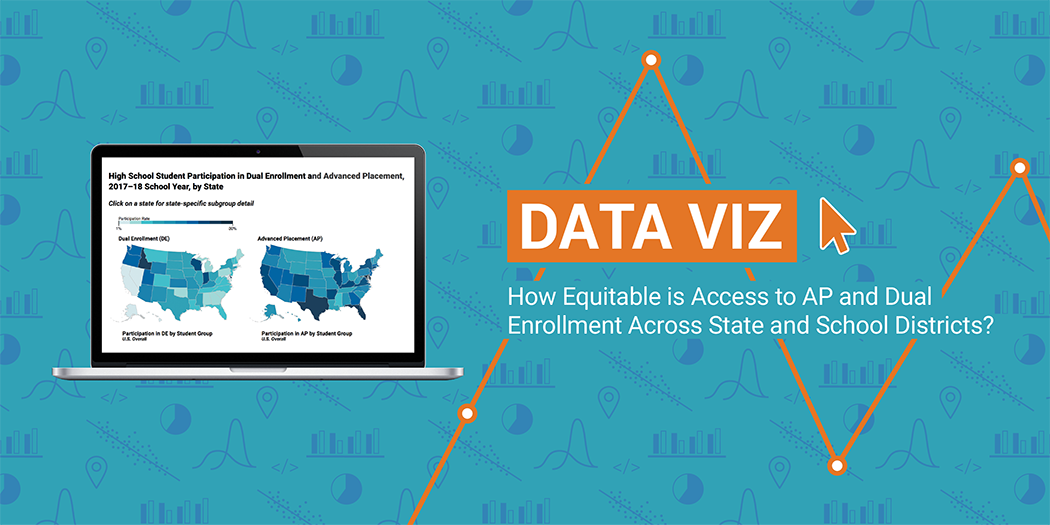Advanced Placement (AP) and dual enrollment are the largest and fastest-growing programs nationally providing high schoolers with early access to college credit. But how equitable is access to these programs, and how can community colleges—which provide the most dual enrollment courses nationally—strengthen their K-12 partnerships to advance equity through dual enrollment?
Using 2017–18 data from the U.S. Department of Education’s Civil Rights Data Collection, the interactive graphics below show state, district-level, and school-level participation in AP and dual enrollment coursework by gender and race/ethnicity.
Mapping Access to AP and Dual Enrollment Among States and Districts
The interactive maps below show participation among public high school students in AP and dual enrollment nationally and by state. Click on a state to further disaggregate participation rates by student race/ethnicity and gender.
New data can be found on this 2025 blog.
Participation in AP and Dual Enrollment by State, 2017–18
Click on a state for state-specific subgroup details
Download the data. For more information on the data source and methodology, see the original state-by-state analysis, detailed school district maps, and accompanying working paper. It is important to note that although the CRDC requires district certification of data upon submission, discrepancies in counts of dual enrollment students between the CRDC data and other data reported by states raises data reporting and quality concerns. For example, data from Colorado and Iowa suggests that these CRDC estimates are underreporting actual participation in dual enrollment. Readers should keep in mind this caveat especially as they examine dual enrollment participation rates.
In the 2017–18 school year, about 10% of high school students nationally took at least one dual enrollment course, and about twice as many took an AP course. Disaggregating participation rates by race/ethnicity and gender reveals widespread equity gaps in access to both AP and dual enrollment coursework. For instance, White high school students enrolled in dual enrollment coursework at about twice the rate of Black students.
Additional patterns emerge when the data are broken out by school district. Toggling between AP and dual enrollment in the map below reveals striking contrasts between the two. A broad view illustrates that AP participation is generally concentrated in urban and coastal areas, while dual enrollment is more widespread across the country, including in many rural communities. A closer look shows that AP and dual enrollment participation and racial equity gaps in access also vary substantially between districts in the same state.
Participation in AP and Dual Enrollment by School District, 2017–18
Hover over a school district for more detail
Show results for:
DE Participation
Gaps in districts with too few students in a particular subgroup are shown as NR (not reported).
With an eye to racial equity gaps—measured by the difference in participation rates between racial/ethnic groups (e.g., White–Black gap)—an even more granular examination reveals that among schools within the same district, too, there can be large differences in access to AP and dual enrollment coursework (see the second tab in the data tool below for school-level data). These findings suggest that even within district and state policy contexts, critical components for enabling equity, what educators do on the most local, school-by-school level can equalize access to early college opportunities.
A Detailed Look at AP and Dual Enrollment Participation by School and District
New Guide on Advancing Equity Through Dual Enrollment
While racial equity gaps in access to AP and dual enrollment coursework are widespread, about one in five districts nationally have closed such gaps in access to dual enrollment. Differences across states and districts in access to dual enrollment—as well as differences in college success after high school among former dual enrollment students—raise important questions about how educators can design these programs to advance equity.
In fall 2020, CCRC and the Aspen Institute released the Dual Enrollment Playbook: A Guide to Equitable Acceleration for Students, which details the practices of nine dual enrollment programs in Florida, Ohio, and Washington that have narrowed or closed equity gaps—both in access to dual enrollment and in post–high school college outcomes—for Black, Latinx, Indigenous, and Pacific Islander students.
These programs, developed through partnerships between high schools and community colleges, show that it is possible to close equity gaps when well-thought-out strategy is paired with innovation and commitment. The playbook identifies five principles and the supporting strategies and practices through which community colleges and K-12 leaders can advance equity in high-quality dual enrollment programs:
- Set a shared vision and goals that prioritize equity.
- Expand equitable access.
- Provide advising and supports that ensure equitable student outcomes.
- Provide high-quality instruction that builds students’ competence and confidence.
- Organize teams and develop relationships to maximize potential.
In addition to the playbook itself, which describes numerous practices and strategies for each of the five principles, CCRC and Aspen released a set of accompanying materials to support the work of colleges and their K-12 partners in redesigning dual enrollment programs to better advance equity:
- Guide to getting started: This guide outlines steps that community college, district, and high school leaders can take to strengthen the equity impact of their dual enrollment programs. It includes discussion questions for internal and partnership-wide meetings, suggestions for whom to invite to those conversations, and recommendations for assessing current practices.
- Equitable practice assessments: Two institutional self-assessment tools—one for community colleges and one for high schools—are designed to help community colleges and high schools assess the alignment of their dual enrollment practices with those described in the Dual Enrollment Playbook.
- Q&A with a college president: Ohio’s Lorain County Community College—one of the sites profiled in the Dual Enrollment Playbook—has been a pioneer in dual enrollment for more than two decades. In “Dual Enrollment as an Engine of Economic Mobility,” LCCC President Marcia Ballinger describes the evolution of the program and its role in growing talent and jobs in the community.





